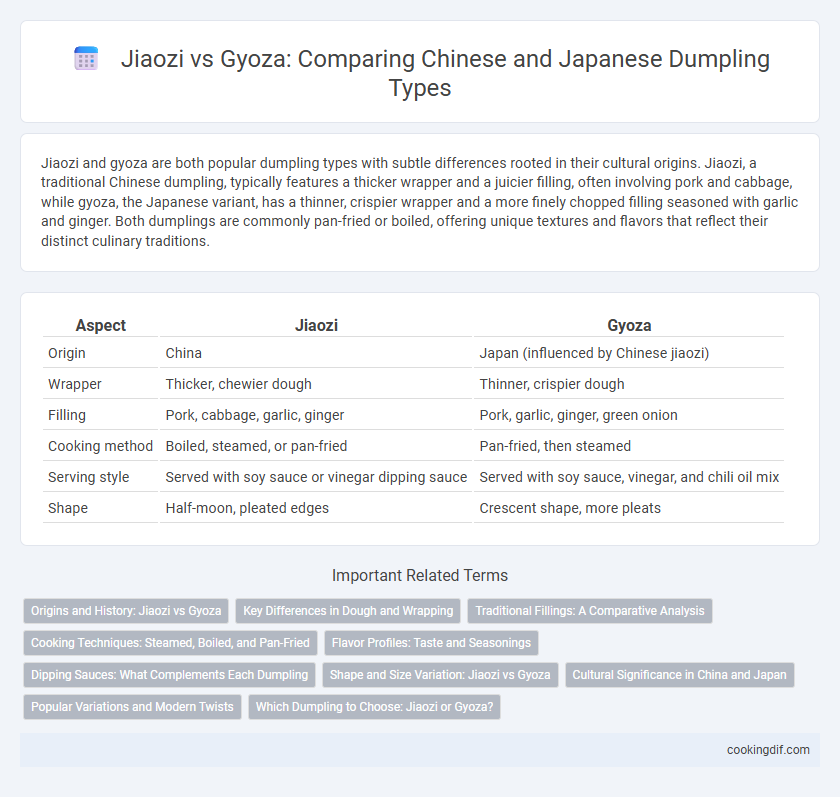Jiaozi and gyoza are both popular dumpling types with subtle differences rooted in their cultural origins. Jiaozi, a traditional Chinese dumpling, typically features a thicker wrapper and a juicier filling, often involving pork and cabbage, while gyoza, the Japanese variant, has a thinner, crispier wrapper and a more finely chopped filling seasoned with garlic and ginger. Both dumplings are commonly pan-fried or boiled, offering unique textures and flavors that reflect their distinct culinary traditions.
Table of Comparison
| Aspect | Jiaozi | Gyoza |
|---|---|---|
| Origin | China | Japan (influenced by Chinese jiaozi) |
| Wrapper | Thicker, chewier dough | Thinner, crispier dough |
| Filling | Pork, cabbage, garlic, ginger | Pork, garlic, ginger, green onion |
| Cooking method | Boiled, steamed, or pan-fried | Pan-fried, then steamed |
| Serving style | Served with soy sauce or vinegar dipping sauce | Served with soy sauce, vinegar, and chili oil mix |
| Shape | Half-moon, pleated edges | Crescent shape, more pleats |
Origins and History: Jiaozi vs Gyoza
Jiaozi originated in China over 1,800 years ago during the Eastern Han Dynasty, traditionally consumed during Chinese New Year to symbolize wealth and prosperity. Gyoza, a Japanese adaptation of jiaozi, emerged after World War II with influences from Chinese migrants, characterized by thinner wrappers and a distinct garlic flavor. Both dumplings share a common heritage but have evolved unique regional ingredients and cooking methods reflecting their cultural backgrounds.
Key Differences in Dough and Wrapping
Jiaozi dough is typically thicker and chewier, made from wheat flour and water without oil, resulting in a soft, pliable texture ideal for boiling or steaming. Gyoza dough tends to be thinner and more delicate, often incorporating a small amount of oil, which creates a slightly crispy texture when pan-fried. The wrapping technique for jiaozi involves pleating more folds to secure the thicker dough, while gyoza uses fewer, finer pleats that enhance the dumpling's delicate structure and crispiness.
Traditional Fillings: A Comparative Analysis
Jiaozi traditionally feature fillings such as ground pork, Napa cabbage, garlic chives, and ginger, reflecting northern Chinese culinary heritage. Gyoza fillings typically include ground pork, cabbage, garlic, and sesame oil, influenced by Japanese adaptations of Chinese Jiaozi. Both dumplings emphasize minced meat and vegetables, but Jiaozi often incorporate stronger seasonings like soy sauce and vinegar, whereas Gyoza maintain a lighter, more delicate flavor profile with a hint of sesame.
Cooking Techniques: Steamed, Boiled, and Pan-Fried
Jiaozi and gyoza are popular dumplings distinguished by their cooking techniques: jiaozi are traditionally boiled or steamed, creating a tender texture, while gyoza are primarily pan-fried, resulting in a crispy bottom and soft top. Steamed jiaozi preserve the dough's softness, and boiling enhances the filling's juiciness, whereas gyoza's pan-frying method adds a savory crunch paired with a juicy interior. These cooking styles reflect regional preferences and significantly influence the dumplings' mouthfeel and flavor profile.
Flavor Profiles: Taste and Seasonings
Jiaozi offers a balanced flavor profile with a subtle blend of ginger, garlic, and soy sauce, creating a savory and slightly sweet taste typical of northern Chinese cuisine. Gyoza features a more intense and garlicky flavor, often enhanced with sesame oil and a hint of vinegar, reflecting Japanese preferences for bold and umami-rich seasonings. Both dumplings highlight distinct regional seasonings but differ in their emphasis on sweetness versus acidity and spiciness.
Dipping Sauces: What Complements Each Dumpling
Jiaozi pairs well with a dipping sauce made from soy sauce, vinegar, and minced garlic, enhancing its savory and slightly tangy flavor profile. Gyoza is typically complemented by a sauce combining soy sauce, rice vinegar, and chili oil, which adds a spicy, umami-rich kick. Both dipping sauces highlight the unique textures and fillings of their respective dumplings while offering a balance of salty, sour, and spicy elements.
Shape and Size Variation: Jiaozi vs Gyoza
Jiaozi dumplings typically feature a crescent-shaped, plump appearance with larger, thicker wrappers that create a substantial bite, while gyoza are smaller, thinner, and have a more delicate crescent shape with tightly pleated edges. The size difference reflects their regional culinary traditions--Jiaozi, popular in northern China, offer a heartier texture and filling, whereas Japanese gyoza emphasize a crispier exterior from pan-frying techniques and a lighter wrapper. This variation in shape and size directly impacts cooking methods, texture, and flavor profiles distinctive to each dumpling type.
Cultural Significance in China and Japan
Jiaozi and gyoza both hold deep cultural significance as traditional dumplings in China and Japan, respectively. Jiaozi symbolize family unity and prosperity, especially during Chinese New Year celebrations, reflecting centuries-old customs. Gyoza, influenced by jiaozi yet adapted to Japanese tastes, represent a popular comfort food integral to Japanese cuisine and social dining.
Popular Variations and Modern Twists
Jiaozi, a traditional Chinese dumpling, typically features thicker wrappers and is often boiled or steamed, showcasing fillings like pork and cabbage, while Japanese gyoza is characterized by thinner, crispier skins and pan-frying techniques that produce a crunchy texture. Popular variations of jiaozi include regional styles such as Shandong's leeks and lamb filling or Sichuan's spicy, numbing seasoning. Modern twists on both dumplings introduce fusion ingredients like truffle oil, seafood blends, or plant-based proteins, catering to global tastes and innovative culinary trends.
Which Dumpling to Choose: Jiaozi or Gyoza?
Jiaozi, traditional Chinese dumplings, are typically larger with thicker wrappers and a juicy filling of pork, cabbage, or chives, making them ideal for boiling, steaming, or pan-frying. Gyoza, the Japanese adaptation, feature thinner wrappers and a more finely minced filling, often with garlic and ginger, resulting in a crispier texture when pan-fried. Choosing between jiaozi and gyoza depends on preference for a chewier texture and versatile cooking methods with jiaozi or a lighter, more delicate dumpling with a signature crispy bottom in gyoza.
Jiaozi vs gyoza for dumpling type Infographic

 cookingdif.com
cookingdif.com